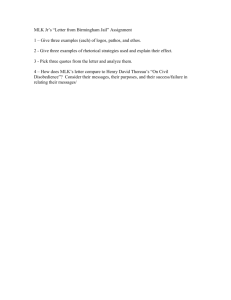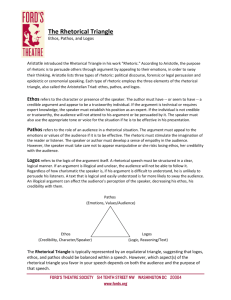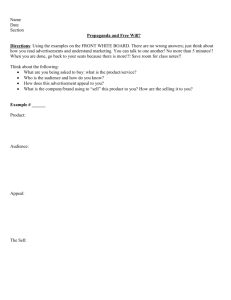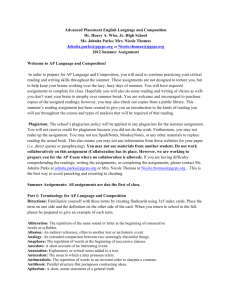The Rhetorical Triangle - Community of Online Research Assignments
advertisement
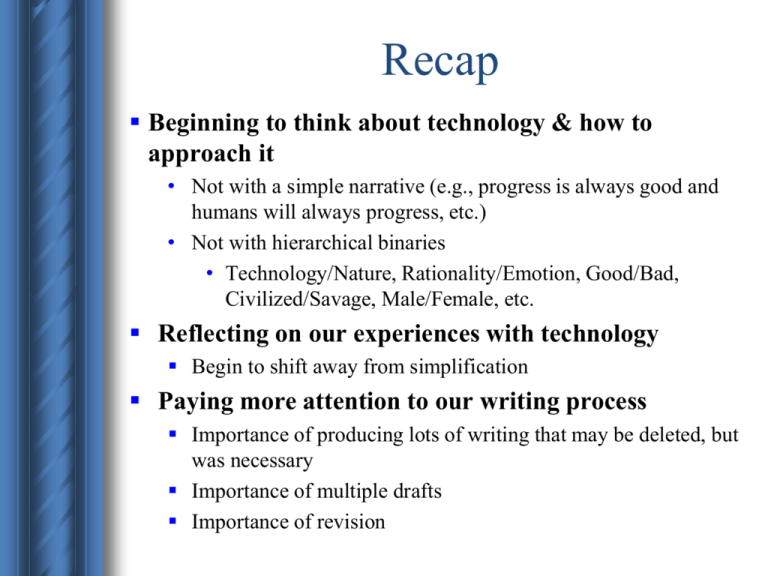
Recap Beginning to think about technology & how to approach it • Not with a simple narrative (e.g., progress is always good and humans will always progress, etc.) • Not with hierarchical binaries • Technology/Nature, Rationality/Emotion, Good/Bad, Civilized/Savage, Male/Female, etc. Reflecting on our experiences with technology Begin to shift away from simplification Paying more attention to our writing process Importance of producing lots of writing that may be deleted, but was necessary Importance of multiple drafts Importance of revision Rhetoric Rhetoric has a few definitions: the art of persuasion the study of language and communication the effective use of language or other methods of communication the practice of making meaning Rhetorical Canons Five categories: serve both analytical and generative purposes. CANON INVOLVES invention discovery of plausible arguments and supporting material arrangement arrangement of argument style fitting of proper language to the argument, based on appropriateness, comprehensibility, and deliberate adornment memory grasp and understanding of the material to be presented delivery control of the elements in the presentation of argument Rhetorical Analysis Analysis unpacking an idea, concept, object, or practice into component parts and looking at relationships. Most analyses ask “why” and “how.” Rhetorical analysis: unpacking how speakers/writers/rhetors use language or other methods to attempt to persuade their audiences by examining the various methods they use to accomplish their task. Text historical definition: a writing that can be interpreted contemporary definition: any object (written, verbal, visual, etc.) that communicates messages (i.e. makes an argument) in a situation Rhetorical Analysis of a Text Key Questions What is said (message) Who is saying it (speaker) Who is listening (audience) Where/when it is being said (situation) Why it is being said (purpose) How it is being said (tone, style) Rhetorical Triangle and Devices Triangle Speaker/Writer – Message – Audience helps understand the context of a text shows the relationships between speaker, audience, message, style, purpose, and tone makes writing and analysis much clearer allows a writer to think more critically about their writing decisions Devices Logos: a logical appeal Quality of reasons and evidence to support point(s) In writing: clear ancedotes, research, data, statistics, logical connections, etc. Pathos: an emotional appeal Consideration of sympathies, values, beliefs, and emotions of audience In writing: vivid examples, details, and empathy with audience Ethos: an ethical appeal Two ways we need to think about ethos: “do this because it’s the right thing to do” Trustworthiness/credibility: “I, the author, am showing you that I am reliable” i.e., “you can trust that I am ethical and telling you what you need to know” My Dear Fellow Clergymen: While confined here in Birmingham city jail, I came across your recent statement calling my present activities “unwise and untimely.” . . . Since I feel that you are men of genuine good will and that your criticisms are sincerely set forth, I want to try to answer your statement in what I hope will be patient and reasonable in terms. I think I should indicate why I am here in Birmingham, since you have been influenced by the view which argues against “outsiders coming in.” . . . I, along with several members of my staff, am here because I was invited here. I am here because I have organizational ties here. But more basically, I am in Birmingham because injustice is here. Just as the prophets of the eighth century B.C. left their villages and carried their “thus saith the Lord” far beyond the boundaries of their home towns, and just as the Apostle Paul left his village of Tarsus and carried the gospel of Jesus Christ to the far corners of the GrecoRoman world, so am I compelled to carry the gospel of freedom beyond my own home town. - Martin Luther King, Jr. “Letter from Birmingham Jail” Ethos Let us begin with a simple proposition: What democracy requires is public debate, not information. Of course it needs information too, but the kind of information it needs can be generated only by vigorous popular debate. We do not know what we need to know until we ask the right questions, and we can identify the right questions only by subjecting our ideas about the world to the test of public controversy. Information, usually seen as the precondition of debate, is better understood as it by product. When we get into arguments that focus and fully engage our attention, we become avid seekers of relevant information. Otherwise, we take in information passively—if we take it in at all. - Christopher Lasch, "The Lost Art of Political Argument" Logos For me, commentary on war zones at home and abroad begins and ends with personal reflections. A few years ago, while watching the news in Chicago, a local news story made a personal connection with me. The report concerned a teenager who had been shot because he had angered a group of his male peers. This act of violence caused me to recapture a memory from my own adolescence because of an instructive parallel in my own life with this boy who had been shot. When I was a teenager some thirtyfive years ago in the New York metropolitan area, I wrote a regular column for my high school newspaper. One week, I wrote a column in which I made fun of the fraternities in my high school. As a result, I elicited the anger of some of the most aggressive teenagers in my high school. A couple of nights later, a car pulled up in front of my house, and the angry teenagers in the car dumped garbage on the lawn of my house as an act of revenge and intimidation. - James Garbarino "Children in a Violent World: A Metaphysical Perspective“ Pathos Rhetorical Triangle Purpose and/or Message Text Speaker/ Writer Audience Context Lloyd Bitzer’s “Rhetorical Situation” Main Elements: Exigence – Audience – Constraints Circumstance Purpose Urgency Response to Message Limitations Situation Activity 1. Work with a partner to find one or two texts online 2. Apply a rhetorical analysis to the text What is said (message) Who is saying it (speaker) Who is listening (audience) Where/when it is being said (situation) Why it is being said (purpose) How it is being said (tone, style) How are rhetorical devices used? 3. Be ready to present to the class Rhetorical Triangle & You 1. Open up your complete draft 2. Underline your main message 3. Bold the most important aspect or perspective about your message that you want the reader to understand 4. Read through your whole paper and highlight when you are using (or could use) logos, ethos, and pathos to support or build toward your message 5. Add or revise sentences or a paragraph that uses one of the devices to support or build toward



